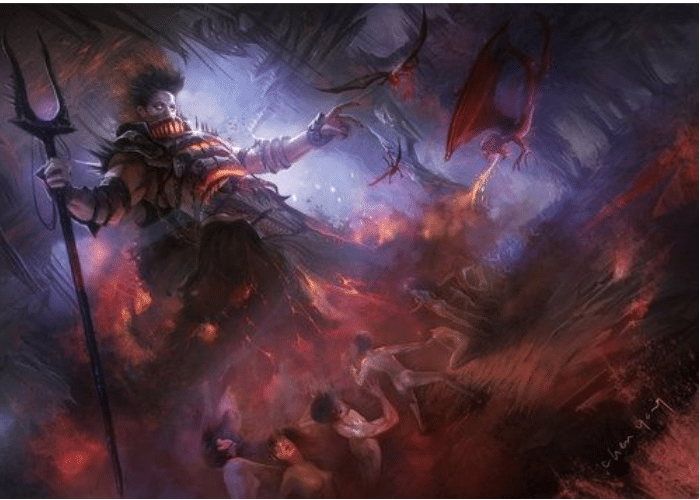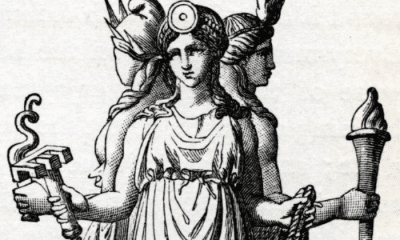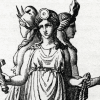
Greek
Tartarus: The Pit of the Underworld
Tartarus: The Pit of the Underworld
If you picture the Greek realm of Tartarus in the same way you usually imagine Hell, you’re not far off. Still, there is a lot more to Tartarus than just a realm of punishment!
Tartarus was both a physical place and a deity. It was one of the primordial forces that drove the creation of the universe.
As a god, Tartarus was rarely mentioned and played little active role in any myths. But as a place, it was one of the major worlds of the Greek universe.
Existing as a pit below Gaia, Tartarus was frequently associated with the underworld. It didn’t start out as just another name for the land of the dead, though.
Tartarus was a land of darkness that Zeus later used as a prison. Soon it was a place of punishment and misery reserved for the worst sinners of the ancient world.
Read on to find out how Tartarus became part of the lands of the dead, and how it influenced ideas in our modern world!
Tartarus and the Primordial Deities
Tartarus was one of the first primordial beings that was created from Chaos. According to Hesiod, Gaia was the first to emerge from the void and Tartarus followed soon after she became solid.
Another, less popular, version of the creation story said that Tartarus was the son of Gaia and Aether, the upper sky.
These first primordial beings were soon joined by more. These included Uranus, the god of the heavens, Oceanus the great river of water, and Nyx the personification of night.
They provided the first and most essential foundations for all gods and eventually all life in the cosmos.
The ancient mystery cults claimed that Tartarus was, in fact, largely responsible for the creation of the universe as they knew it.
They claimed that the god Tartarus released the first ever being from which light and life were born.
Tartarus was more than just an early god, though. He was an entire realm.
The Great Pit
Tartarus as a place was often described as the pit. The Greeks imaged the universe as having the shape of an egg – the earth was flat firmament cutting across the centre while the heavens arched above and Tartarus curved below.
He resided below Gaia. Exactly how far below was a matter of some debate.
Hesiod envisioned the cosmos in three basic layers. He said that if you were to drop a bronze anvil from the heavens it would take nine days to reach earth, and a further nine days to reach Tartarus.
In the Iliad, Homer added an extra dimension to the map of the cosmos. He said that the anvil would take nine days to reach the realm of Hades, the land of the dead, from earth but that it would take another nine for it to finally hit Tartarus.
The earth was, by this measure, twice as far removed from Tartarus as it was from the heavens.
Tartarus was a gloomy place, so far removed from the light of the heavens that it was perpetually black and barren.
Originally, Tartarus and the underworld were two entirely separate planes of existence.
Over time, however, they became linked so that Tartarus was thought of as a space within or connected to the realm of Hades.
The Prison of Tartarus
As a part of Hades, Tartarus became a prison realm. It was the place where exceptionally wicked and evil people were sent to be punished for their crimes.
This ideal of Tartarus as a place of punishment began before Zeus even rose to power. His father Chronos had, according to some accounts, taken the six giant children of Gaia and moved them to Tartarus to be imprisoned.
When Zeus conquered the Titans and became king of the gods, Chronos ended up in Tartarus in place of his monstrous siblings.
[The hundred-handed Hekatonkheires] overshadowed the Titanes with their missiles, and buried them beneath the wide-pathed earth, and bound them in bitter chains when they had conquered them by their strength for all their great spirit, as far beneath the earth to Tartaros (Tartarus) … Round it runs a fence of bronze, and night spreads in triple line all about it like a neck-circlet, while above grow the roots of the earth and unfruitful sea.
There by the counsel of Zeus who drives the clouds the Titan gods are hidden under misty gloom, in a dank place where are the ends of the huge earth. And they may not go out; for Poseidon fixed gates of bronze upon it, and a wall runs all round it on every side, and a wall runs all round it on every side. There [the Hekatonkheires] Gyes and Kottos (Cottus) and great-souled Obriareus live, trusty warders of Zeus who holds the aigis.
-Hesiod, Theogony 715 ff
Tartarus had officially been established as a prison realm and it would be many ages before the Titans were released from it.
As time went on, the pit also came to be seen as a place of imprisonment for sinful human souls.
Most of the dead went to the underworld, the realm of the dead that was ruled by Hades. Eventually, Tartarus came to be seen as something of an annex to that realm.
The majority of people went to the gloomy Asphodel Meadows. A select few enjoyed the paradise of the Elysian Fields.
But the truly wicked, the people who deserved the most severe punishments, were sentenced to tortures in Tartarus.
Often these were people who had committed offenses against the gods and their laws.
Tantalus, for example, had cooked and served his own son when invited to serve a meal for the gods. For this terrible crime he spent eternity up to his neck in a pool of dark water he could never drink with a bunch of grapes always just out of reach, forever tormented by nagging hunger and thirst.
Sisyphus betrayed Zeus’s confidence and violated the sacred laws of hospitality by killing visitors to his palace. He then tried to evade Thanatos twice and cheat fate.
His punishment was to push a giant boulder up a hill for all eternity. Whenever he neared the summit of the hill, the boulder rolled back down and he would have to start over.
The Danaides were a group of sisters who murdered their husbands. They spent their time in Tartarus carrying jugs of water to fill a bath that could wash away their sins, but the bathtub was full of cracks so the water always drained out before it was deep enough to bathe in.
Ixion killed his father-in-law, then tried to assault Hera. He was tied to a flaming wheel that first spun around the heavens, but was later relocated to Tartarus.
Greek philosophers debated the nature of Tartarus and the people condemned there.
Socrates believed that it was far worse to commit and injustice than to be the victim of one, so the worst people in Tartarus were the kings and other powerful men who had used their earthly power to hurt others.
Plato believed that temple robbers and murderers could not atone, but that those who had killed in a fit of rage and regretted their crimes should only be in Tartarus for a year. After that, the philosopher said they should be given a chance to apologize to their victims and make amends.
Tartarus was clearly reserved for the worst criminals. It was a place of punishment for murderers and those who had sinned directly against the gods.
Children of the Pit
When the primordial gods began to shape the cosmos, they reproduced to create the beings that would inhabit it.
Many of these children were the first generations of the gods. Others were the ancestors of monsters.
Because Tartarus was a realm of darkness, many of his children were more monstrous. Although most were born to Gaia, the mother earth who had given rise to all life and the great Titan gods, they were of a darker variety.
Many of Gaia’s children were called the children of Tartarus or Uranus by different writers. Those attributed to Tartarus included:
- The Gigantes – The one hundred giants were often depicted with the tails of snakes. They waged a war against the gods, the Gigantomachy, but were defeated.
- Echidna – The serpentine woman was, with her brother Typhon, the mother of many of Greek mythology’s most fearsome and deadly monsters.
- Typhon – Arguably the most infamous of Tartarus and Gaia’s children, Typhon was a monstrous giant raised to overthrow Zeus. He had serpentine features, power over the wind, and could breathe fire. When Zeus defeated him he was imprisoned in Tartarus.
- The Telchines – Sometimes described as the sons of Tartarus and Nemesis, the Telchines were four powerful sea magicians who inhabited the island of Rhodes. They crafted the adamantine sickle used to castrate and overthrow Uranus.
Tartarus and Erebus
Tartarus was sometimes conflated with Erebus, the primordial god of darkness.
Erebus had existed before the sun and moon were created. He continued to thrive in the dark recesses of the realm of Tartarus.
Erebus, too, was sometimes described as having his own place in the cosmos. It was a land of mystery, cloaked in eternal darkness, from which monsters and nightmares escaped.
The god of darkness, perhaps predictably, became linked with death and the underworld. While the land of Erebus was not a part of the underworld, he came to be thought of as a god of death.
As primordial gods both associated with darkness, monsters, and the underworld, Erebus and Tartarus became linked in the minds of Greek people.
While Tartarus continued to be referred to on his own, Erebus was often named as a part of Tartarus or another name for that place and god instead of as an independent deity.
The Origins of Hell
The idea of Tartarus as a part of the underworld became an important one in the modern world, as well.
As Christianity gained popularity in Europe, the original Hebrew texts of the Old Testament were translated into both Greek and Latin.
Some Greek translations made use of the word Tartarus to describe ideas in Judaism that may have been foreign to European readers. Tartarus, therefore, is named as the place where the fallen angels are imprisoned after their rebellion.
The idea of a deep place under the earth where those who broke divine law are punished for eternity has an obvious parallel in the Christian idea of Hell.
Some Christian writers extended the comparison, drawing parallels between the imprisoned Titans and Lucifer’s fallen angels, for example.
Writers like Dante imagined the Christian Hell in a way that was very obviously based on the Greek Tartarus. In Inferno the Hell of the Christian world is populated by famous figures from Greco-Roman mythology and history.
While the Christian idea of Hell has some differences, it is obvious that European Christianity was influenced by the Greek idea of punishment in the afterlife. Just as Zeus condemned evil men like Tantalus and Sisyphus to Tartarus, the Christian god condemns men who violate his laws.
The Realm and God of Tartarus
Tartarus was both a primordial god of the ancient Greek religion and a physical realm. The Greeks believed that Tartarus existed as an inverted dome beneath the earth, just as the heavens formed a dome above the earth.
As a god Tartarus was not a major figure. He served as a personification of his realm.
Tartarus was described as a pit, and soon became associated with the underworld. It was a place of imprisonment and punishment.
The first prisoners to be locked away in Tartarus after the rise of the Olympian gods were the Titans they had fought against.
Eventually, Tartarus became more closely linked to the underworld and was seen as a place of punishment for evil men as well as enemy gods.
Greek philosophers debated the nature of Tartarus and whether the people sent there could hope for eventual redemption. While most agreed that some people there had a hope of being cleansed of their sins, most philosophers believed that some people were too corrupt to ever atone.
Tartarus was a realm of darkness that gave rise to giants and mythical monsters.
As belief in Greco-Roman religion faded, the concept of Tartarus as a place of punishment influenced the growing Christian faith’s image of Hell and eternal damnation.




